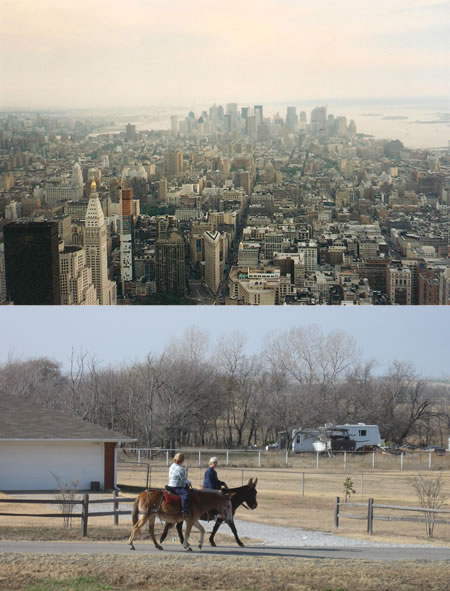 These photos have one thing in common. I took them both on working days as an apparel patternmaker. The upper photo is from the Empire State Building looking toward south Manhattan in New York City, in view of a couture design room where I worked. The lower photo was taken from a front window of my home in the rural Western United States, just steps away from my home office where I am starting a business publishing patterns after having gained experience with other companies in various sizes of communities. Trucks, farm machines and country animals share the streets and fields surrounding my home office, a contrast to the skyscrapers, taxis and occasional exotic breed of leashed dog that filled my view on New York streets.
These photos have one thing in common. I took them both on working days as an apparel patternmaker. The upper photo is from the Empire State Building looking toward south Manhattan in New York City, in view of a couture design room where I worked. The lower photo was taken from a front window of my home in the rural Western United States, just steps away from my home office where I am starting a business publishing patterns after having gained experience with other companies in various sizes of communities. Trucks, farm machines and country animals share the streets and fields surrounding my home office, a contrast to the skyscrapers, taxis and occasional exotic breed of leashed dog that filled my view on New York streets.
Entrepreneurs rarely have the luxury of choice as to where to base their businesses. Home, wherever it is, usually offers the most economical office space solution for start-ups. However, for entrepreneurs who are able to choose, this article may provide helpful considerations. This author's experience includes jobs with fashion companies in small towns, with populations ranging from 4,000 to 45,000, and also with companies in Manhattan in New York, the most populous city in the United States.
My first small-town job was a summer college internship with Lands' End, an apparel and home products manufacturer founded by yachting enthusiast Gary Comer, who moved his mail-order operation from a Chicago store basement to "the middle of a cornfield in Wisconsin" as business expanded. The headquarters in Dodgeville, Wisconsin, now employs over 4,000 people, close to the same number as the town's population. Some of the employees choose to settle in Madison, the state capital with a quarter of a million population, and drive two hours round trip to work every day so that their children can enjoy the benefits of living in a larger metropolitan area. Lands' End employees who are already married seem content enough with the rural office location, but the single employees generally regret the lack of social life and resulting low potential for meeting a spouse among Dodgeville's small population. The city of Madison is far away enough that most employees make the trip only occasionally.
The next two small-town companies for which I worked manufactured children's wear. They were successful in their own niches, with annual sales volumes of several million, though tiny compared to Lands' End's over 1 billion annual revenue. What is interesting to note is that these companies of differing sales volumes, all based in small towns and including my own rural-based business into this mix, share location effects that stand in opposition to the environmental pros and cons of the companies I worked for in the big city of New York. The trade-offs balance closely in my opinion.
 Rural Area and Small Town Considerations for Fashion Business Locations
Rural Area and Small Town Considerations for Fashion Business Locations
A small town can be a wonderful place to live and raise a family. If a business is economically viable when based in a rural area, many people prefer to pursue that route, and this list demonstrates why, with clear benefits and negotiable obstacles.
Advantages:
- Low cost of living
- High quality of life
- Clean air
- Quick commute to work
- Safe communities where conservative values are championed
- Low cost of business operation
Disadvantages:
- Limited retail sales market
- Difficulty in finding or relocating qualified workers (Lands' End operates call centers in other cities to source additional workers)
- Distance barriers must be overcome to shipping, supplier and trade show hubs (for example, professional models, sales reps, and FedEx shipping semi trucks make special trips to Lands' End headquarters, and employees travel out to trade shows and supplier offices)
- Limited social opportunities, leading to a feeling of isolation and loneliness, especially for unmarried workers
- Limited educational opportunities for workers' children
Big City Considerations for Fashion Business Locations
Fashion design and manufacturing businesses can operate from almost any size town, but several brilliant advantages are realized by locating in fashion hubs like New York or Los Angeles. In decades past, cities in addition to New York or Los Angeles would have qualified as fashion hubs, but as fashion production has been mostly outsourced offshore, the fashion industry in the United States has become concentrated in those two cities. A limited number of suppliers are based in other large cities, but none outside of New York or Los Angeles are still considered fashion manufacturing or design hubs. A retail fashion business, of course, needs only a large enough population to support the sales volume desired.
Advantages:
- Shippers, suppliers and trade shows are local (this was once a major advantage, but online resources are changing the importance of local sourcing)
- Sustainable retail sales market
- Easy to find a large pool of qualified workers who already live in the city
- Social opportunities abound, addressing a vast range of interests
- Workers' children have access to a full palate of educational opportunities
Disadvantages:
- High cost of living is rarely completely offset by increased wages, leading to lower net income compared to workers in smaller cities
- Quality of life is often low
- Air pollution
- The typical commute to work is time consuming
- Crime rates are high, and community support for conservative values is low
- Rising costs of business taxation and overhead are forcing many New York and Los Angeles fashion businesses to close or relocate to smaller cities
Living in a big city like New York can be a fun experience, and for someone who is starting a fashion business, no other location is more ideal for networking with an endless array of suppliers. From another perspective, several of my former co-workers who have spent decades in New York advised me to stay where I am to start my business, in my rural neighborhood filled with horse stables, and travel to New York only when needed. The lists provided above give a hint as to why, with quality of life considerations.
